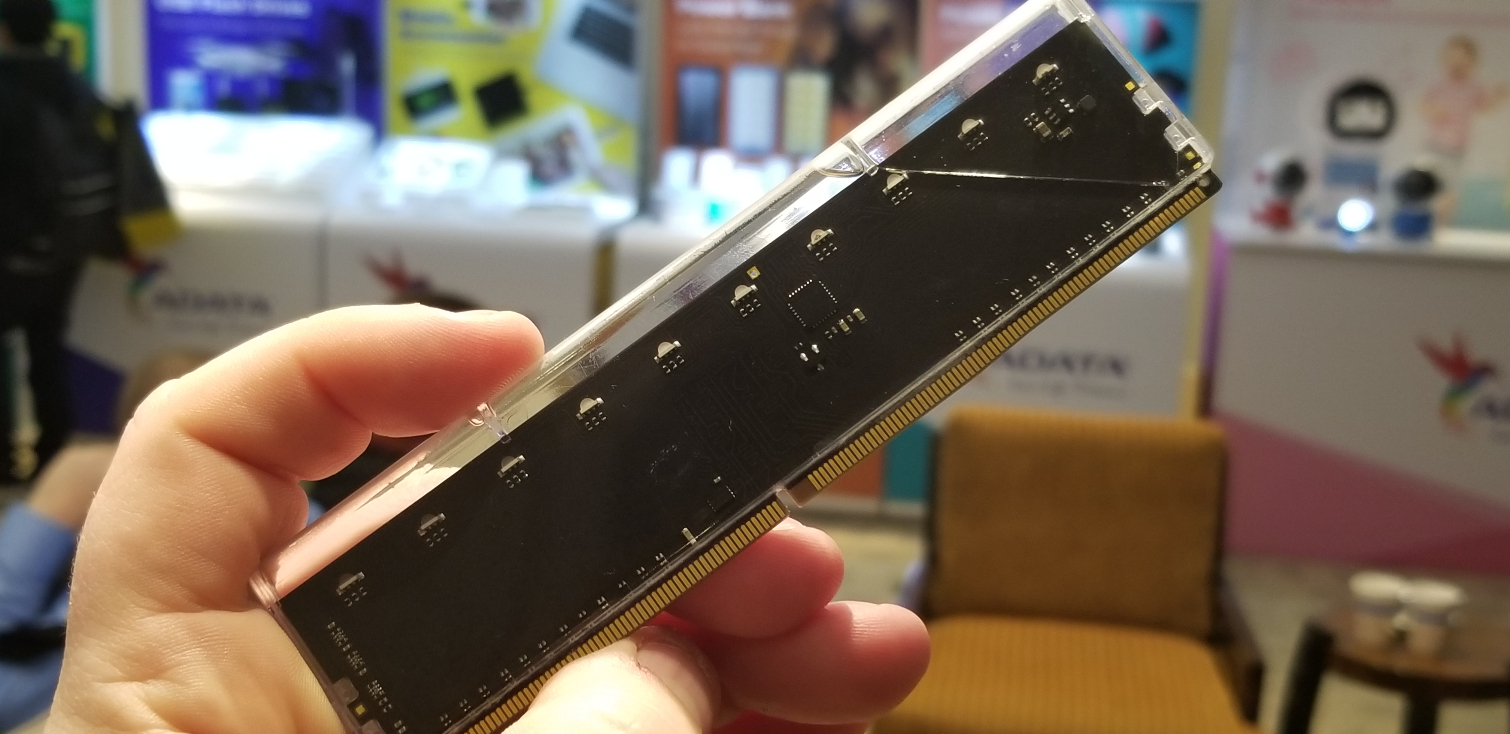Exotic Cooling In Adata 'JellyFish' RAM Project
LAS VEGAS, NV -- Adata's Project JellyFish isn't the wildest system memory design we've ever seen, but it's certainly the...wettest. At CES 2018, the company displayed a working prototype of a fluid-filled plastic shell that encapsulated a fairly traditional DDR4 DIMM. The liquid inside the housing is non-conductive and has been used for exotic computer displays for years by companies looking for attention at trade shows.
Adata is the first that we know of to combine the chemical in a DRAM module. We were told the company has a patent on the design, but don't expect to purchase JellyFish DRAM anytime soon. We were told these are working prototypes but not final designs. At this time, we're not even sure if this product will come to market.
The JellyFish DDR4 DIMMs feature a row of LEDs across the top of the circuit board that alternate colors when powered on. The display was fairly low tech, with a simple display that just powers the two drives Adata had in the booth. Adata didn't run the RAM in a system, so we don't know the true cooling capabilities. If these come to market, we should expect some way to cool the liquid. An expansion chamber would also help to raise the level of fluid in the module. In the prototypes we saw on display, the liquid didn't cover every DRAM package on the board. The top packages would go without liquid cooling in an upright desktop computer.
Get Tom's Hardware's best news and in-depth reviews, straight to your inbox.

Chris Ramseyer was a senior contributing editor for Tom's Hardware. He tested and reviewed consumer storage.
-
AnimeMania The amount of pressure you have to push down on the plastic covered RAM to seat it properly, tells me this is not going to be a good idea.Reply -
Giroro Reminds me of the PC builds that I've seen inside of an aquarium full of ... I forget. (Mineral oil?).Reply
They always left me thinking "okay, so now the heat is away from the chips, but how do you get it out of the big plastic tank?" The oil might start out cold, but given enough time the fluid itself will still heat up to a dangerous level if you can't transfer heat into the air. That's why traditional liquid cooling has a radiator. -
Jeff Fx Reply20606079 said:Liquid to keep it cool and a plastic case to do the opposite of that.
It seems like they're just doing something weird and useless to get attention. It worked. -
bigpinkdragon286 Have I missed something? When did RAM start having issues with heat you couldn't solve through normal air cooling methods?Reply -
derekullo Filling all of the nooks and crannies around the ram module with a thermally conductive liquid would increase the surface area that the hot areas of the ram module are in contact with thereby allowing the heat to dissipate faster through conduction from the ram module to the thermally conductive liquid.Reply
At this point you run into 2 possibilities for the casing, non thermally conductive polymers and thermally conductive polymers.
https://www.google.com/search?&q=thermally+conductive+polymers
Whether or not you need to cool the liquid with a radiator type cooling solution depends on how conductive the plastic/polymer casing around the liquid is.
If the plastic they use is not thermally conductive then all of the heat would indeed stay in the thermally conductive liquid inside of the ram module, necessitating a radiator type cooling solution to remove the heat from the system.
If the plastic could made suitably conductive then a radiator type device would not be needed for an adequate cooling solution.
Fans would complete the cooling turning the device into a heatsink.
The only way to tell the difference without them telling us what kind of polymer is in use would be to see the ram in action with devices able to monitor the temperature of the thermally conductive liquid and the plastic casing .
The closer the temperature between the plastic casing and the thermally conductive liquid the higher the thermal conductivity of the plastic casing would have to be. -
niz Its probably at best a marginal improvement that they've turned into a net loss by also putting a bunch of heat-producing LEDs in, because you know... looks are more important than functionality.Reply
